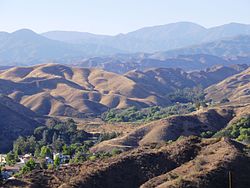| Sierra Pelona | |
|---|---|
| Sierra Pelona Mountains | |
 View from Santa Clarita | |
| Highest point | |
| Peak | Burnt Peak [1] |
| Elevation | 5,791 ft (1,765 m) |
| Coordinates | 34°40′57″N118°34′36″W / 34.6825°N 118.5768°W |
| Naming | |
| Etymology | Spanish for "Bald Mountains" |
| Geography | |
Location of Sierra Pelona Ridge in California [2] | |
| Location | Los Angeles County, California, U.S. |
| Parent range | Transverse Ranges |
The Sierra Pelona, also known as the Sierra Pelona Ridge [2] or the Sierra Pelona Mountains and originally known as the Liebre Mountains, is a mountain ridge in the Transverse Ranges in Southern California. [3] Located in northwest Los Angeles County, the ridge is bordered on the north by the San Andreas Fault and lies within and is surrounded by the Angeles National Forest and a tiny section in the Los Padres National Forest


